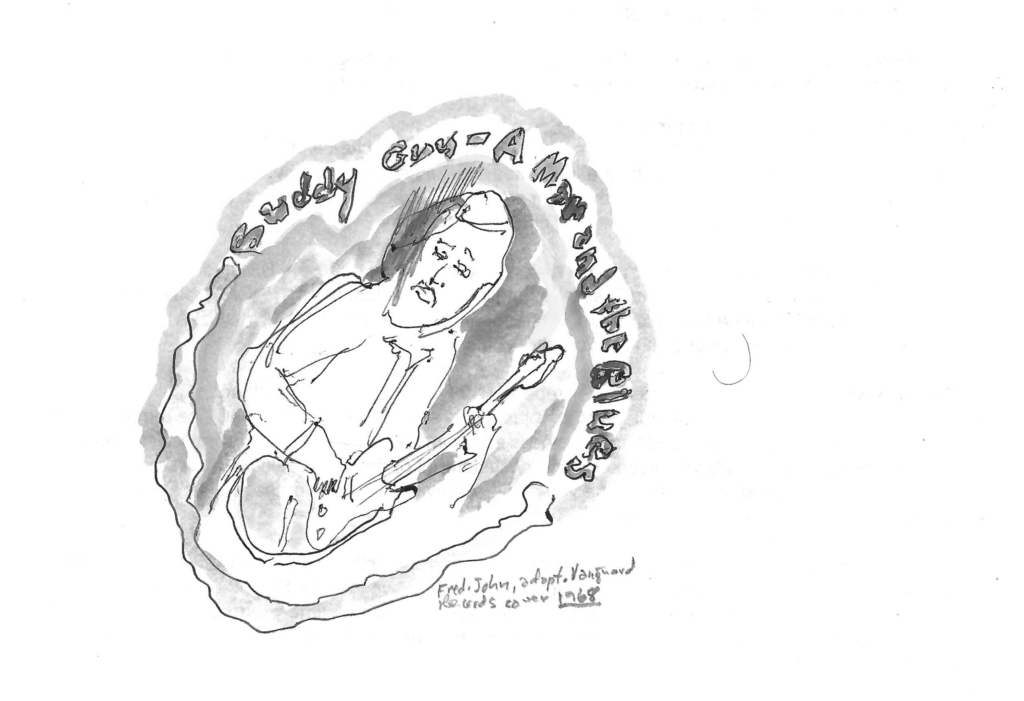Was it Foster, the nightman being gutted by JP’s vicious Doberman watchdog? Or simply the obliteration of the orange day-glo mural heralding the names of Jimmy Dean, Roy Clark, Cowboy Copas, Nat King Cole and others from the storied, scabby walls at Cousin Nick’s tavern? And the doubling up in price for shots of scotch, bourbon and beer?
Hard to say, but clearly the 1973 magic had sprinkled itself all around the tubular vastness of the “club opposite the cable-car barn.” The old heavyset Greek who’d opened the joint circa 1949 was now gone, and his flaky cannabis-besotted grandsons had run the club into the ground.
But my lifetime chum Little Bobby had taken the place by storm in late ‘72, dazzling his blues, his crowd bedazzled following with the spotlight’s glare bouncing off his bright red Gibson ES-335 guitar.
And in addition to playing the role of “Roadie” [for Bobby] for the first time in my life — rolling unwieldy speaker cabinets and bass drum through Nick’s tight little doorway — I heard the slurred devoration of “Jew Boy” for the first time in my life outside 4708 14th St. N.W.
Spoiler alert: I am not of Jewish origin. Interestingly, Chicago lads like Mike Bloomfield and Mark Naftalin were Jewish and wealthy heirs of mercantile and political families who sought refuge in the shadows of Blues world.
So here in funky Brightwood D.C., across from the tower of the old Trolley Barn (now Metrobus garage), a stooped, drunken small-time merchant I’ll call “Tuck,” berated my hanging with the “Blues Jews.”
Of course, Tuck admired my gritty refusal to play the race card. He had put up Muddy Waters in one of his enterprises — a seedy rooming house on T St. down in Shaw. Too bad he didn’t realize I’d played the same harmonized licks alongside “Master Mud ” on the stage of the world-renowned Cellar Door Club of Georgetown. I’d been brought into Mr. Waters’s circle via the goodwill of Bob Margolin, the band’s new rhythm guitarist, whose monster sound did not detract from his Boston Hebraic roots. Backstage before the show, Bob M., myself, Muddy and the suave bassist Calvin “Fuzz” Jones slapped cards on the table in the wild hands of ‘Tonk.’
Meanwhile at the cavelike-cranny that had morphed into a musical church, mustachioed characters sought to bribe Little Bobby into bringing them on stage in exchange for gifts — bags of pot and related substances.
“Harper” on the blues harp, “Neon Leon” on vocals, and “LSQ” who even offered our local star a new ebony-coloured ES 335 to manage his gigs. No such luck. But I stood alongside my buddy with my cheap Teisco “axe” and tore out “That Did It,” by Bobby “Blue” Bland. Sadly, after old Nick’s fatal heart attack, the club soon folded. Little Bobby and I reunited in ‘78 in New York.
Just playin’ my axe
In ‘91 or maybe early ‘92, (the mind wanders a bit and loses specifics), I squatted proudly on a “comped” perch along the back bar “peanut gallery” of Blues Alley, Georgetown, D.C.
Funny thing — here I was in the throes of quitting “the grape;” parked on a barstool in the dimmest quarter of a dingy shrine to what some call “devil music” — blues and jazz! But giving up drinking alcohol would not quash my love of 1-4-5 chords and raggy bop beats — oh no! Nor would I boycott my beloved “Alley!”
Buddy Guy, king of all things Chicago and Delta Electric Blues (when BB King was off the stage), had answered my phone call just that afternoon. He’d come into D.C. just to play his show at Blues Alley, and he knew I was kinda low on friends, trying to rebuild my life in the Hometown District.
“Sure John, be glad to ‘sponsor’ you for the early show.” He closed with a chuckle, “might not be able to have you and your guitar up there, you know?”
“Hey, Buddy! No problem.” I thanked him profusely. He’d just been recording across the pond in London. A far cry from bustin’ chops backing KoKo Taylor and even the (Violinaires) Gospel Group in the early 60s up in the cold Chess Records Studios.
Ironically, Buddy opened the set with one of my personal highlight tunes from his rich and lengthy portfolio: “Just Playin’ My Axe.” Just as my mnemonic memory skips useless trivia with alacrity, the relevant visual cues never fade with time.
Mr. Guy beams from the cover of his eponymous Vanguard LP label where he leans back, addressing a generic night-club spotlight, hot rays bouncing off his neatly coiffed pompadour. His striped dress shirt glows off his iridescent Fender Stratocaster guitar.
Perhaps the pictured artist was singing about his beloved “Axe” in the Vanguard cover photo! Who knows, but while I was living at the South Greenwood Avenue home of Vince, KoKo’s drummer, Buddy took me under his wing frequent afternoons in 1980 while he co-managed the storied club Checkerboard Lounge over on 43rd Street (beneath the elevated train platform).
At that time, Buddy Guy was under doctor’s orders to remain in Chi-town. His high blood pressure was raging and too much travel could prove fatal! But there was a bright side, for sitting at Buddy (and his rhythm man Lefty’s) knee was where I learned to turn it downward and play those sweet notes. And in 2002, my band “Blues Museum” graced the Blues Alley Stage ourselves for the first time!




